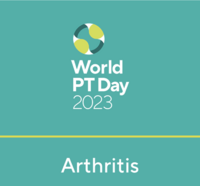World PT Day
About World PT Day[edit | edit source]
World PT Day is on 8th September every year. The day is an opportunity for physiotherapists from all over the world to raise awareness about the crucial contribution the profession makes to keeping people well, mobile and independent.
In 1996, the World Confederation of Physical Therapy (WCPT) now known as World Physiotherapy designated 8th September as World PT Day. This is the date World Physiotherapy was founded in 1951.
The day marks the unity and solidarity of the global physiotherapy community. It is an opportunity to recognise the work that physiotherapists do for their patients and community. Using World PT Day as a focus, World Physiotherapy aims to support member organisations in their efforts to promote the profession and advance their expertise.
Reports from around the world indicate that World PT Day activities have a positive impact on the profession’s profile and standing with both the public and policy makers.
Many World Physiotherapy member organisations already have their own national physical therapy days, weeks and months. However, organisations that have no designated day of their own often choose 8th September.
It is up to individual physiotherapists and World Physiotherapy member organisations to decide what activities and materials they wish to develop. That way, they can reflect key national priorities and messages. But each year World Physiotherapy provides ideas, publicity and support materials.
2023[edit | edit source]
The focus for this year’s World PT Day is arthritis, with an in-depth look at some forms of inflammatory arthritis, including rheumatoid arthritis and axial spondyloarthritis. This follows on from the theme for 2022, which focused on osteoarthritis.
The campaign is focused on the following key messages:
- Arthritis is defined as an acute or chronic joint inflammation. Symptoms can include pain, swelling, stiffness, and redness which may contribute to reduced function and dexterity. Arthritis isn’t a single condition; there are many different types.
- It can affect people of all ages and physical fitness – including children, teenagers, and athletes. Some forms of arthritis are more common in older people.
- The symptoms of arthritis can vary from week to week, and even from day to day. It can also affect people in different ways and each condition will have specific symptoms. However, with the right treatment and approach, you can manage your symptoms and live well.
- Regular physical activity and exercise are important in the management of all forms of inflammatory arthritis (IA), including rheumatoid arthritis (RA) and axial spondyloarthritis (axial SpA), and offer numerous health benefits.
- Physiotherapy is an important part of your overall treatment. A physiotherapist will guide you on how to exercise safely, increase your activity levels, set goals, and find the right balance between rest and activity.
- It’s important to stay active and keep moving when you have arthritis. Physiotherapists are part of a multidisciplinary team that can help you manage your arthritis. They will be able to assess your condition and abilities and guide you on how to keep active and help manage your symptoms.
- People with RA and other inflammatory joint disorders have an increased risk of cardiovascular disease (CVD). Healthy lifestyle choices, including regular physical activity, are important in the management of RA to reduce the risk of CVD.
- People with axial SpA should be referred to a physiotherapist to start an individualised, structured exercise programme that is tailored to you to help maintain spinal flexibility, whole body flexibility, and reduce pain. Even when you have pain, continuing to exercise at levels that suit you has significant benefits.
- Only about a third of people living with OA will get worse over time, and some see an improvement in pain and disability. A physiotherapist will be able to guide you on how to keep active.
- Arthritis is often associated with older people, but it can also affect children. Most types of childhood arthritis are known as juvenile idiopathic arthritis (JIA). Physiotherapy forms an important role in the management of the symptoms of JIA and will help you/your child do the activities you like doing.
2022[edit | edit source]
The focus for this year’s World PT Day on 8 September is osteoarthritis and the role of physiotherapists in its prevention and in the management of people affected by osteoarthritis. In 2022 the focus will be on other rheumatological conditions.
The campaign is focused around the following key messages.
- Osteoarthritis (OA) is the most common joint condition: 520 million people around the world have OA, and 60% of OA cases are for knee OA.
- In a global study of 291 conditions, hip and knee OA was ranked as the 11th highest contributor to disability.
- The exact cause of OA is unclear. Risk factors that increase the risk of OA include: having overweight or obesity, having a previous joint injury or joint surgery or history of joint overuse, genetics.
- Exercise is a first-line treatment for OA. A physiotherapist can provide advice and education about pain relief and ways to manage OA. They can teach people living with OA how to improve joint movement and strengthen muscles.
- It is important for people living with OA to keep as active as possible. This can help improve pain, reduce other symptoms of OA, and help people stay independent.
- Only about a third of people living with OA will get worse over time, and some see an improvement in pain and disability. A physiotherapist will be able to guide you on how to keep active.
World Physiotherapy encourages member organisations and physiotherapists around the world to use World Physiotherapy’s toolkit to convey these messages to the public and policy makers.







